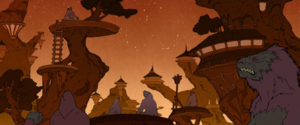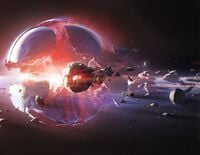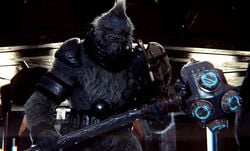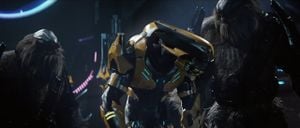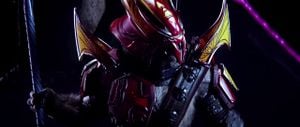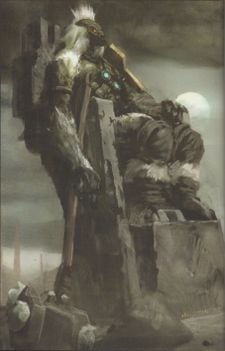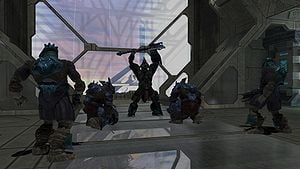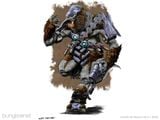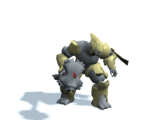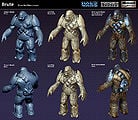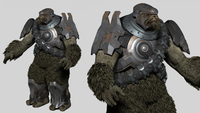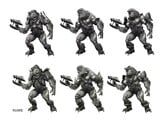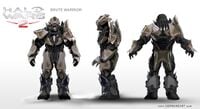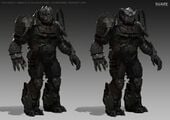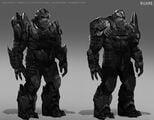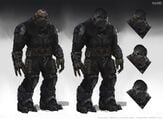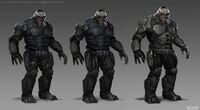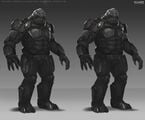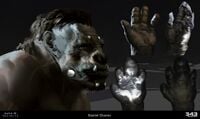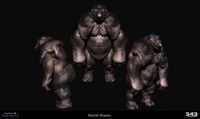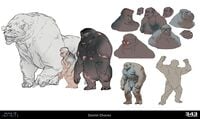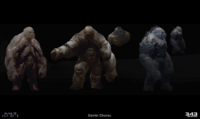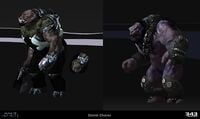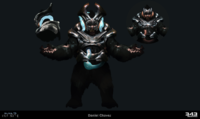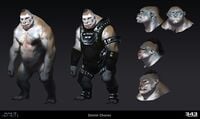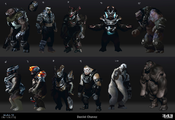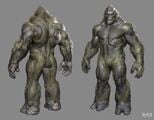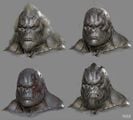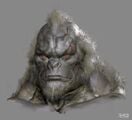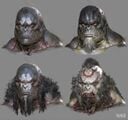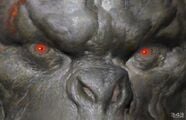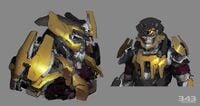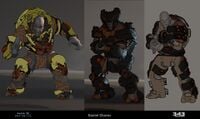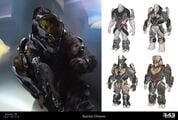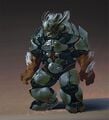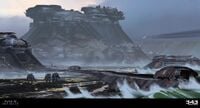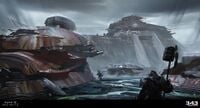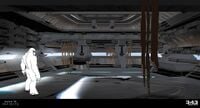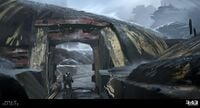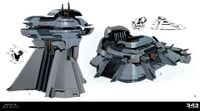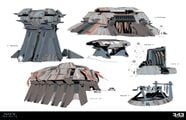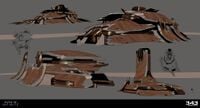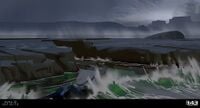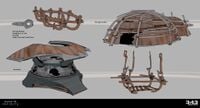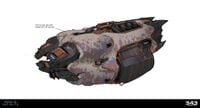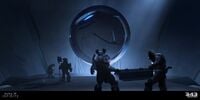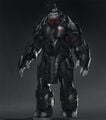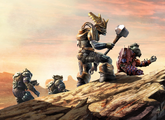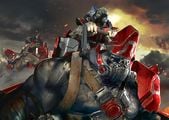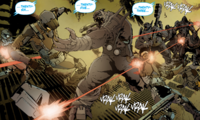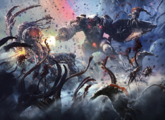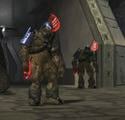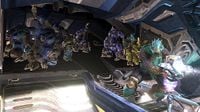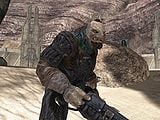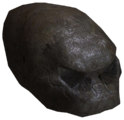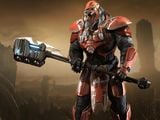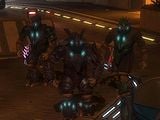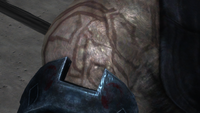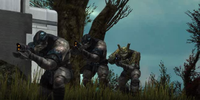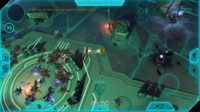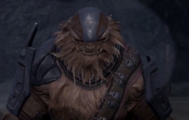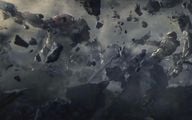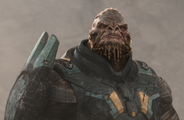Jiralhanae: Difference between revisions
From Halopedia, the Halo wiki
mNo edit summary |
Sith Venator (talk | contribs) |
||
| (15 intermediate revisions by 9 users not shown) | |||
| Line 50: | Line 50: | ||
When the Covenant encountered the Jiralhanae circa [[2492]] CE, they fought resulting in several battles. Although some Jiralhanae were quick to join the Covenant, such as those led by [[Jiralhanae Chieftain|Chieftain]] [[Maccabeus]],<ref>'''Halo: Contact Harvest''', ''page 260''</ref> others put up resistance against the invading alien hegemony.<ref name="bc187">'''[[Halo: Broken Circle]]''', ''page 187''</ref> In their primitive state they were quickly defeated and absorbed into the Covenant.{{Ref/Reuse|ch194}} The Jiralhanae's search for theological meaning led to the species' swift incorporation into the Covenant as they adopted the [[Covenant religion|empire's religion]] and began worshiping the [[Forerunner]]s.{{Ref/Reuse|bc187}} | When the Covenant encountered the Jiralhanae circa [[2492]] CE, they fought resulting in several battles. Although some Jiralhanae were quick to join the Covenant, such as those led by [[Jiralhanae Chieftain|Chieftain]] [[Maccabeus]],<ref>'''Halo: Contact Harvest''', ''page 260''</ref> others put up resistance against the invading alien hegemony.<ref name="bc187">'''[[Halo: Broken Circle]]''', ''page 187''</ref> In their primitive state they were quickly defeated and absorbed into the Covenant.{{Ref/Reuse|ch194}} The Jiralhanae's search for theological meaning led to the species' swift incorporation into the Covenant as they adopted the [[Covenant religion|empire's religion]] and began worshiping the [[Forerunner]]s.{{Ref/Reuse|bc187}} | ||
The Jiralhanae serve in the [[Covenant military]], deployed as heavy infantry and shock troops. Most of the Jiralhanae roles within the Covenant were only mere extensions of their own clan-based organizational structure, albeit more formalized under the Covenant's rule.{{Ref/Reuse|wp jiralhanae}} The Covenant settled Jiralhanae on worlds rich in resources to guard them from anyone seeking to claim them for themselves. Meanwhile, the Jiralhanae lacked the capability to mine the resources themselves and were not provided the technologies necessary for the process, ensuring that the Prophets had secure control over the resources.<ref name="esc1">'''[[Halo: Escalation]]''', ''[[Halo: Escalation Issue 1|Issue #1]]''</ref>{{Ref/Site|Id=CFShocks|URL=https://www.halowaypoint.com/news/canon-fodder-system-shocks|Site=Halo Waypoint|Page=Canon Fodder - System Shocks|D=30|M=06|Y=2023}}{{Ref/Site|Id=S4Intel|URL=https://www.halowaypoint.com/news/infection-intel|Site=Halo Waypoint|Page=Halo Infinite - Infection Intel|D=16|M=08|Y=2023|LocalArchive=Halo Infinite Story & Intel}} Upon the Jiralhanae's inclusion into the Covenant, a group of [[Sangheili]] commanders went before the Covenant [[High Council]] and claimed that the Jiralhanae's pack mentality would inevitably bring conflict between the two species. Citing the Jiralhanae's natural instincts to fight to the top of any hierarchy, the Sangheili commanders proposed that any peaceful "urges" that the Jiralhanae exhibited should be "aggressively encouraged". The High Council believed that the argument was fair, and began to impose restrictions on the technology the Jiralhanae could access. Although this ruling was meant to curb the enmity between the Sangheili and Jiralhanae, a feud between the two species | The Jiralhanae would serve in the [[Covenant military]], deployed as heavy infantry and shock troops. Most of the Jiralhanae roles within the Covenant were only mere extensions of their own clan-based organizational structure, albeit more formalized under the Covenant's rule.{{Ref/Reuse|wp jiralhanae}} The Covenant settled Jiralhanae on worlds rich in resources to guard them from anyone seeking to claim them for themselves. Meanwhile, the Jiralhanae lacked the capability to mine the resources themselves and were not provided the technologies necessary for the process, ensuring that the Prophets had secure control over the resources.<ref name="esc1">'''[[Halo: Escalation]]''', ''[[Halo: Escalation Issue 1|Issue #1]]''</ref>{{Ref/Site|Id=CFShocks|URL=https://www.halowaypoint.com/news/canon-fodder-system-shocks|Site=Halo Waypoint|Page=Canon Fodder - System Shocks|D=30|M=06|Y=2023}}{{Ref/Site|Id=S4Intel|URL=https://www.halowaypoint.com/news/infection-intel|Site=Halo Waypoint|Page=Halo Infinite - Infection Intel|D=16|M=08|Y=2023|LocalArchive=Halo Infinite Story & Intel}} Upon the Jiralhanae's inclusion into the Covenant, a group of [[Sangheili]] commanders went before the Covenant [[High Council]] and claimed that the Jiralhanae's pack mentality would inevitably bring conflict between the two species. Citing the Jiralhanae's natural instincts to fight to the top of any hierarchy, the Sangheili commanders proposed that any peaceful "urges" that the Jiralhanae exhibited should be "aggressively encouraged". The High Council believed that the argument was fair, and began to impose restrictions on the technology the Jiralhanae could access. Although this ruling was meant to curb the enmity between the Sangheili and Jiralhanae, a feud between the two species would continue.<ref name="ch199">'''Halo: Contact Harvest''', ''page 199''</ref> | ||
===Human-Covenant War=== | ===Human-Covenant War=== | ||
| Line 57: | Line 57: | ||
Jiralhanae troops fought in many battles throughout the [[Human-Covenant War]], including the [[First Battle of Harvest|first conflict]] on [[Harvest]] and the [[Fall of Reach|invasion]] of [[Reach]].<ref name="contact">'''Halo: Contact Harvest'''</ref><ref name="reach">'''Halo: Reach''', campaign level ''[[New Alexandria]]''</ref> While effective combatants, they remained subordinate to the Sangheili, who continued to regard the Jiralhanae with near-universal disdain. Receiving differing opinions and suggestions on how to deal with the threat of [[human]]ity by both [[San'Shyuum]] and Sangheili, the [[Prophet of Truth|High Prophet of Truth]] began pursuing numerous schemes as he sought to replace the Sangheili with the Jiralhanae; Truth considered the latter to be easier to control and more dogmatic. [[Tartarus]], a Jiralhanae who participated in the first contact on Harvest, caught the eye of the [[Hierarch]], who was impressed that the Jiralhanae managed to take control of the entire [[Rh'tol]] skein at a young age. In the final years of the Human-Covenant War Truth had prepared Tartarus for an ascension to military authority.{{Ref/Reuse|wp jiralhanae}} | Jiralhanae troops fought in many battles throughout the [[Human-Covenant War]], including the [[First Battle of Harvest|first conflict]] on [[Harvest]] and the [[Fall of Reach|invasion]] of [[Reach]].<ref name="contact">'''Halo: Contact Harvest'''</ref><ref name="reach">'''Halo: Reach''', campaign level ''[[New Alexandria]]''</ref> While effective combatants, they remained subordinate to the Sangheili, who continued to regard the Jiralhanae with near-universal disdain. Receiving differing opinions and suggestions on how to deal with the threat of [[human]]ity by both [[San'Shyuum]] and Sangheili, the [[Prophet of Truth|High Prophet of Truth]] began pursuing numerous schemes as he sought to replace the Sangheili with the Jiralhanae; Truth considered the latter to be easier to control and more dogmatic. [[Tartarus]], a Jiralhanae who participated in the first contact on Harvest, caught the eye of the [[Hierarch]], who was impressed that the Jiralhanae managed to take control of the entire [[Rh'tol]] skein at a young age. In the final years of the Human-Covenant War Truth had prepared Tartarus for an ascension to military authority.{{Ref/Reuse|wp jiralhanae}} | ||
By the final months of the war the High Prophet of Truth had gathered the personal allegiance of many of the [[San'Shyuum High Councilor|San'Shyuum members]] on the High Council.<ref>'''Halo: Broken Circle''', ''page 196''</ref> Recognizing the Jiralhanae's ferocity and unquestioning obedience, the San'Shyuum had decided to promote the Jiralhanae to the top of the Covenant military hierarchy — a position occupied by the Sangheili since the Covenant's inception. The Sangheili were scapegoated for failing to prevent the recent assassination of the [[Prophet of Regret|High Prophet of Regret]] (secretly arranged by Truth), and their previous failure to safeguard [[Installation 04]]; these events were used to justify the decision.<ref>'''Halo: Broken Circle''', ''page 209''</ref> The Jiralhanae became the Hierarchs' chosen protectors, [[Changing of the Guard|replacing]] the [[Sangheili Honor Guardsman|Sangheili Honor Guardsmen]] and taking command of the [[Covenant fleet|fleet]]. This event led to some Sangheili Councilors to threaten resignation from the High Council.<ref name="changeguard">'''Halo 2''', campaign level ''[[Sacred Icon]]''</ref> On [[2552#November|November 3, 2552]], Tartarus and the High Prophet of Truth enacted their plans after several decades of preparation. After Tartarus seemingly killed [[Arbiter]] [[Thel 'Vadamee]],<ref name="QZ">'''Halo 2''', campaign level ''[[Quarantine Zone]]''</ref> the Chieftain's second-in-command, [[Melchus]], led a massacre on the Sangheili High Councilors and several of the former Honor Guardsmen on [[Installation 05]].<ref>'''Halo: Broken Circle''', ''pages 219-222''</ref> These acts began the [[Great Schism]], a civil war that forced the Sangheili out of the Covenant proper, resulting in the fracturing of the Covenant empire. Tartarus attempted to initiate the Great Journey by activating Installation 05 but he was slain by the Arbiter and the [[Fleet of Retribution]], | By the final months of the war the High Prophet of Truth had gathered the personal allegiance of many of the [[San'Shyuum High Councilor|San'Shyuum members]] on the High Council.<ref>'''Halo: Broken Circle''', ''page 196''</ref> Recognizing the Jiralhanae's ferocity and unquestioning obedience, the San'Shyuum had decided to promote the Jiralhanae to the top of the Covenant military hierarchy — a position occupied by the Sangheili since the Covenant's inception. The Sangheili were scapegoated for failing to prevent the recent assassination of the [[Prophet of Regret|High Prophet of Regret]] (secretly arranged by Truth), and their previous failure to safeguard [[Installation 04]]; these events were used to justify the decision.<ref>'''Halo: Broken Circle''', ''page 209''</ref> The Jiralhanae became the Hierarchs' chosen protectors, [[Changing of the Guard|replacing]] the [[Sangheili Honor Guardsman|Sangheili Honor Guardsmen]] and taking command of the [[Covenant fleet|fleet]]. This event led to some Sangheili Councilors to threaten resignation from the High Council.<ref name="changeguard">'''Halo 2''', campaign level ''[[Sacred Icon]]''</ref> On [[2552#November|November 3, 2552]], Tartarus and the High Prophet of Truth enacted their plans after several decades of preparation. After Tartarus seemingly killed [[Arbiter]] [[Thel 'Vadamee]],<ref name="QZ">'''Halo 2''', campaign level ''[[Quarantine Zone]]''</ref> the Chieftain's second-in-command, [[Melchus]], led a massacre on the Sangheili High Councilors and several of the former Honor Guardsmen on [[Installation 05]].<ref>'''Halo: Broken Circle''', ''pages 219-222''</ref> These acts began the [[Great Schism]], a civil war that forced the Sangheili out of the Covenant proper, resulting in the fracturing of the Covenant empire. Tartarus attempted to initiate the Great Journey by activating Installation 05 but he was slain by the Arbiter and the [[Fleet of Retribution]],{{Ref/Marketing|Id=LongRoad|Halo Waypoint|The Long Road Home}} who had formed a tentative alliance with the UNSC.<ref name="journey">'''Halo 2''', campaign level ''[[The Great Journey]]''</ref>{{clear}} | ||
===Post-war=== | ===Post-war=== | ||
| Line 194: | Line 194: | ||
File:HR BruteMinorConcept.jpg|A close-up of the top right Jiralhanae variation. | File:HR BruteMinorConcept.jpg|A close-up of the top right Jiralhanae variation. | ||
File:H4_BruteChieftain_Concept.jpg|Cut concept for a large Jiralhanae in ''[[Halo 4]]''. | File:H4_BruteChieftain_Concept.jpg|Cut concept for a large Jiralhanae in ''[[Halo 4]]''. | ||
File:H2A Brutes Concept 1.jpg|Concept art of the Brutes for ''[[Halo 2: Anniversary]]''. | |||
File:H2A Brutes Concept 2.jpg|Concept art of the Brutes for ''Halo 2: Anniversary''. | |||
File:HW2 BanishedBrute Concept.jpg|Concept art of Banished Jiralhanae for ''[[Halo Wars 2]]''. | File:HW2 BanishedBrute Concept.jpg|Concept art of Banished Jiralhanae for ''[[Halo Wars 2]]''. | ||
File:HW2 Banished Brutes Concept 1.jpg|Concept art of Banished Jiralhanae. | File:HW2 Banished Brutes Concept 1.jpg|Concept art of Banished Jiralhanae. | ||
| Line 280: | Line 282: | ||
File:H4 SPARTAN-II against Jiralhanae.jpg|A Brute Chieftain against a Spartan-II. | File:H4 SPARTAN-II against Jiralhanae.jpg|A Brute Chieftain against a Spartan-II. | ||
File:JiralhanaeChieftain SpartanAssault.png|A Jiralhanae Chieftain fighting against [[SPARTAN-IV program|Spartan]] [[Edward Davis|Davis]] in ''[[Halo: Spartan Assault]]''. | File:JiralhanaeChieftain SpartanAssault.png|A Jiralhanae Chieftain fighting against [[SPARTAN-IV program|Spartan]] [[Edward Davis|Davis]] in ''[[Halo: Spartan Assault]]''. | ||
File:H2A BruteCU.png|A Jiralhanae in ''[[Halo 2: Anniversary]]''. | File:H2A BruteCU.png|A Jiralhanae Major in ''[[Halo 2: Anniversary]]''. | ||
File:Jiralhanae Warlord - Combat.jpg|A Jiralhanae Warlord killing UNSC Marines in ''[[Know Your Enemy]]''. | File:Jiralhanae Warlord - Combat.jpg|A Jiralhanae Warlord killing UNSC Marines in ''[[Know Your Enemy]]''. | ||
File:HW2-Banished.png|Banished Jiralhanae on Installation 00 in ''Halo Wars 2''. | File:HW2-Banished.png|Banished Jiralhanae on Installation 00 in ''Halo Wars 2''. | ||
| Line 376: | Line 378: | ||
**''[[Forever We Fight]]'' | **''[[Forever We Fight]]'' | ||
*''[[Halo Infinite]]'' | *''[[Halo Infinite]]'' | ||
*''[[Halo: The Television Series]]'' | *''[[Halo: The Television Series Season One]]'' | ||
**''[[Reckoning]]'' | **''[[Reckoning]]'' | ||
**''[[Transcendence]]'' | **''[[Transcendence]]'' | ||
*''[[Halo: The Rubicon Protocol]]'' | |||
*''[[Halo: Outcasts]]'' | *''[[Halo: Outcasts]]'' | ||
*''[[Halo: Battle for the Blood-Moon]]'' | |||
*''[[Halo: Trial of Reckoning]]'' | |||
*''[[Halo: The Television Series Season Two]]'' | |||
**''[[Aleria (TV Series)|Aleria]]'' | |||
*''[[Halo: Fireside]]'' | |||
*''[[Halo: Epitaph]]'' | |||
*''[[Halo: The Third Life]]'' | |||
*''[[Halo: Age of Retribution]]'' | |||
{{Col-end}} | {{Col-end}} | ||
Latest revision as of 11:59, November 8, 2024
| Jiralhanae | |
|---|---|
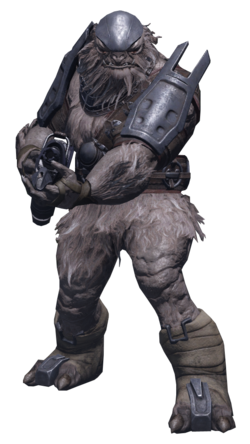
| |
| Biological overview | |
|
Latin name: |
Servus ferox |
|
Classification: |
Pseudo-ursine mammal |
|
Diet: |
Omnivorous[1] |
| Physical information | |
|
Avg. height: |
259 centimeters (8 ft 6 in)—280 centimeters (9 ft 2 in)[2][3] |
|
Avg. weight: |
1,125 pounds (510 kg)–1,500 pounds (680 kg)[3] |
|
Distinctions: |
Simioid physiology; thick, shaggy fur; prominent fangs |
| Sociocultural information | |
|
Homeworld: |
|
|
Notable individuals: |
|
|
Also known as: |
|
- "They are beasts, in essence and action."
- — The Minister of Discovery remarking on the savage nature of the Jiralhanae[5]
The Jiralhanae (Servus ferox in Latin taxonomy, translated to "wild slave"[6]), known by humans as Brutes, are a mostly carnivorous sapient species of pseudo-ursine mammals.[2][3] Originating from the planet Doisac, the Jiralhanae were the final addition to the Covenant hegemony. The Jiralhanae typically have a profound hatred of the Sangheili,[7][8] unmatched by any other feud within the Covenant.[9] This rivalry was fueled by the Jiralhanae's naturally aggressive and dominating demeanor clashing with the Sangheili's societal sense of superiority over them at the time of the Covenant.[10][11]
Immensely strong (surpassing the strength of both Sangheili and Spartan-IIs), Jiralhanae typically place a greater emphasis on brutality than wisdom; they are considered to be a savage species on the whole. Preferring this potential for blind obedience, the High Prophet of Truth began plans to replace the Sangheili with Jiralhanae, slowly placing the latter in higher positions and giving them greater allowances than Sangheili troops would receive.[12] Finally, on Truth's orders, the Jiralhanae began a purge of Sangheili High Councilors and commanders throughout Covenant space, sparking a cataclysmic civil war known as the Great Schism that led to the dissolution of the Covenant. This conflict against the Sangheili would continue well after the end of the Human-Covenant War and like the Sangheili, the Jiralhanae would fight internally as well.[13]
History[edit]
The Ark and reseeding[edit]
The Jiralhanae were one of the many species of predators that originated on Doisac, evolving from temperamental, tree-dwelling mammals due to Doisac's challenging and diversifying environment.[3] The Jiralhanae were one of many sentient species indexed by the Librarian for preservation aboard Installation 00. After the Halo Array was fired, the Jiralhanae were returned to Doisac to begin rebuilding their culture.[14]
The First Immolation[edit]
While commonly regarded as a savage species, Jiralhanae proved intelligent enough to achieve Tier 4 status. However, their warlike nature inevitably led them into conflict, and eventually the various Jiralhanae master-packs — belonging into either of the Jiralhanae's two main social divisions (the Rh'tol and Vheiloth skeins) fell into a massive war known as the First Immolation.[3] This mechanized war of attrition lasted a decade and eventually led to the use of nuclear weapons that devastated Doisac.[15] The First Immolation and the nuclear holocaust that followed nearly led to species self-extinction and caused the collapse of Jiralhanae society; by 2492 CE, the species had just rediscovered radio and rocketry.
The Covenant[edit]
When the Covenant encountered the Jiralhanae circa 2492 CE, they fought resulting in several battles. Although some Jiralhanae were quick to join the Covenant, such as those led by Chieftain Maccabeus,[16] others put up resistance against the invading alien hegemony.[17] In their primitive state they were quickly defeated and absorbed into the Covenant.[15] The Jiralhanae's search for theological meaning led to the species' swift incorporation into the Covenant as they adopted the empire's religion and began worshiping the Forerunners.[17]
The Jiralhanae would serve in the Covenant military, deployed as heavy infantry and shock troops. Most of the Jiralhanae roles within the Covenant were only mere extensions of their own clan-based organizational structure, albeit more formalized under the Covenant's rule.[3] The Covenant settled Jiralhanae on worlds rich in resources to guard them from anyone seeking to claim them for themselves. Meanwhile, the Jiralhanae lacked the capability to mine the resources themselves and were not provided the technologies necessary for the process, ensuring that the Prophets had secure control over the resources.[18][19][20] Upon the Jiralhanae's inclusion into the Covenant, a group of Sangheili commanders went before the Covenant High Council and claimed that the Jiralhanae's pack mentality would inevitably bring conflict between the two species. Citing the Jiralhanae's natural instincts to fight to the top of any hierarchy, the Sangheili commanders proposed that any peaceful "urges" that the Jiralhanae exhibited should be "aggressively encouraged". The High Council believed that the argument was fair, and began to impose restrictions on the technology the Jiralhanae could access. Although this ruling was meant to curb the enmity between the Sangheili and Jiralhanae, a feud between the two species would continue.[21]
Human-Covenant War[edit]
- "The Great Journey has begun, and the Brutes, not the Elites, shall be the Prophets' escort!"
- — Tartarus, to the Arbiter[22]
Jiralhanae troops fought in many battles throughout the Human-Covenant War, including the first conflict on Harvest and the invasion of Reach.[23][24] While effective combatants, they remained subordinate to the Sangheili, who continued to regard the Jiralhanae with near-universal disdain. Receiving differing opinions and suggestions on how to deal with the threat of humanity by both San'Shyuum and Sangheili, the High Prophet of Truth began pursuing numerous schemes as he sought to replace the Sangheili with the Jiralhanae; Truth considered the latter to be easier to control and more dogmatic. Tartarus, a Jiralhanae who participated in the first contact on Harvest, caught the eye of the Hierarch, who was impressed that the Jiralhanae managed to take control of the entire Rh'tol skein at a young age. In the final years of the Human-Covenant War Truth had prepared Tartarus for an ascension to military authority.[3]
By the final months of the war the High Prophet of Truth had gathered the personal allegiance of many of the San'Shyuum members on the High Council.[25] Recognizing the Jiralhanae's ferocity and unquestioning obedience, the San'Shyuum had decided to promote the Jiralhanae to the top of the Covenant military hierarchy — a position occupied by the Sangheili since the Covenant's inception. The Sangheili were scapegoated for failing to prevent the recent assassination of the High Prophet of Regret (secretly arranged by Truth), and their previous failure to safeguard Installation 04; these events were used to justify the decision.[26] The Jiralhanae became the Hierarchs' chosen protectors, replacing the Sangheili Honor Guardsmen and taking command of the fleet. This event led to some Sangheili Councilors to threaten resignation from the High Council.[12] On November 3, 2552, Tartarus and the High Prophet of Truth enacted their plans after several decades of preparation. After Tartarus seemingly killed Arbiter Thel 'Vadamee,[27] the Chieftain's second-in-command, Melchus, led a massacre on the Sangheili High Councilors and several of the former Honor Guardsmen on Installation 05.[28] These acts began the Great Schism, a civil war that forced the Sangheili out of the Covenant proper, resulting in the fracturing of the Covenant empire. Tartarus attempted to initiate the Great Journey by activating Installation 05 but he was slain by the Arbiter and the Fleet of Retribution,[29] who had formed a tentative alliance with the UNSC.[22]
Post-war[edit]
- "Vengeance is petty. Vengeance has no reward."
- — Atriox responding to Resa 'Azavayl's animosity towards his species.[30]
After the Covenant's disastrous defeat at the Ark, Jiralhanae society began to splinter.[3] Many Jiralhanae refused to cease their campaigning against the Sangheili and the two species remained locked in an irregular conflict for years to come. Some Jiralhanae served Tem'Bhetek and Boru'a'Neem in a genocidal plot against the Sangheili that was ultimately foiled. When the remaining San'Shyuum retreated into hiding, the Jiralhanae returned to their primitive, savage nature, allowing the Sangheili to gain the upper hand in battle. Some Jiralhanae factions had separated from those loyal to the former Covenant and were waging an internecine war against each other and thus the Brutes, like their Elite counterparts, were fighting in a two-front war.[13] This lack of solidarity made the Jiralhanae easier prey for some of the Sangheili commanders who were genocidally hunting them.[31][32]
On Doisac, conditions worsened as the Jiralhanae master-packs and tribes fought among themselves while the organization imposed on their species by the Covenant fell apart. Additionally, due to the Jiralhanae's lack of advanced technology, they were unable to attain resources or even food for themselves, instead resorting to raids on Sangheili settlements which resulted in the deaths of several Sangheili civilians.[33] Notably the Rh’tol Jiralhanae glorified these raids as power over their oppressors.[34] This, in turn, only served to provoke further violence between the two species.[18] As the Sangheili-Jiralhanae conflict continued to escalate, one master-pack sought peace. On March 5, 2558, the Jiralhanae Chieftain Lydus and his master-pack the Children of Oth Sonin were willing to begin peace talks with the Swords of Sanghelios under the mediation of the United Nations Space Command.[18] Lydus, along with several of his bodyguards met with the Arbiter and Lord Hood on Ealen IV, however these initial peace talks were foiled by a mercenary group attack hired by the Insurrectionists known as the New Colonial Alliance.[35]
Due to animosity stoked by the Great Schism, the Jiralhanae and Sangheili typically did not work together after the war, at least not as equals.[36] A small minority of Jiralhanae had chosen to work under some Sangheili as slave laborers or lesser infantry for reasons unknown. A few Jiralhanae, such as Manus and the crew of Piety, remained loyal to their Sangheili superiors during the split of the Covenant.[3][37] A few others served the Sangheili as security guards and servants on Sanghelios. However, this did not come without conflict. In March 2553, Jiralhanae servants in the state of Ontom launched insurgent attacks, which resulted in the death of dozens of Sangheili. Their revolt was quickly quelled by the city militia.[38] Some Jiralhanae created or joined Jiralhanae-led remnant factions such as the Keepers of the One Freedom. In September 2558, a Jiralhanae faction led by Hekabe known as the Voice of Maardoth formed a brief uneasy alliance with a Sangheili faction led by Thars 'Sarov during the Carrow Conflict. However, the Jiralhanae quickly betrayed and attacked them as Hekabe's true intention was to access a Sharquoi hive and use the creatures to seize ultimate power for himself, these plans were thwarted by the local human militia, Gray Team and Rojka 'Kasaan.[39] The Banished, a mercenary organization that had rebelled against the Covenant in the 2540s, was led by and predominantly composed of Jiralhanae. They began to amass a considerable degree of power in the war's aftermath, invading the Ark in 2559 and occupying Installation 07 in 2560.[40][41] Jiralhanae clans hidden in corners throughout the Orion Arm continued to gather strength, intent on resuming the work of the dissolved Covenant.[42]
While the Sangheili and Jiralhanae continued their genocidal battles through 2559,[31] Doisac had been subdued by the Created uprising. Several of Cortana's Guardians were sent to the Jiralhanae homeworld to enforce martial law as she did with all major worlds across the Orion Arm.[43] Atriox, leader of the Banished, was called to answer to Cortana's rule, to which he defied. This defiance led Cortana to unleash her wrath upon his kind for disobedience and her Created Guardians fired several beams that destroyed the planet. The world of Doisac was no more.[44]
The Jiralhanae continued to survive, scattered across the galaxy.[42] Lydus and his people fled to an abandoned human colony with some allegedly still lurking in the shadows of their home system,[45] the Banished sought to make Installation 07 their faction's new home,[44] and others relocated to the worlds of Gathved, Ordun Dal, and Savadok.[46]
Biology[edit]
Anatomy and physiology[edit]
Jiralhanae are a carnivorous, sapient species of mammals[2] who share physical characteristics with Earth's gorillas, rhinoceros, and bears; due to their bear-like features, they are designated pseudo-ursines.[3] They have thick skin that ranges in color from dark grey to dark and light brown and makes them highly resistant to harm,[7] and their bodies are covered with matted tan,[22] grey,[12] white, brown,[47] rust-red[48] or black fur.[3] Some Jiralhanae, such as those of the Vheiloth skein, shave their fur,[49] with higher-ranking individuals sporting beards or mohawks.[47] Pale fur and skin are considered extremely rare.[50]
Their large, stocky appearance is most likely due to the gravity on their planet, which is about twice that of Earth. Jiralhanae are immensely strong, hence the "Brute" moniker, and are capable of delivering crushing blows in hand-to-hand combat; in addition to having an extraordinary physical endurance. Their teeth are very sharp, and are frequently used as natural weapons. They are prone to fits of berserk rage in battle; Brutes often rush at and pummel any targets within reach with terrifying aggression. Jiralhanae have three digits on each hand plus opposable thumbs. As such they can make use of a variety of weapons both of Covenant and human design. Their feet have only two digits, each with thick, hardened claws.[3] Jiralhanae blood is purplish-red.
Jiralhanae are consummate carnivores and have evolved as predators, as evidenced by their fearsome fanged jaws and propensity for violence. They are known to eat the flesh of their enemies, such as humans. They consider thorn beast a delicacy.[51] Prior to the latter's appointment as Arbiter, a Jiralhanae prison guard stated he would have gladly devoured Thel 'Vadamee had he been allowed.[52] Jiralhanae have highly sensitive olfactory glands that allow them to quickly track down and hunt prey, even in unfamiliar territories.[3]
Jiralhanae often descend into a highly aggressive berserker rage when all their pack mates have been killed. Their incredible physical strength coupled with a dogged determination to kill their target makes a berserk Jiralhanae a force to be reckoned with, some being powerful enough to even kill a Mgalekgolo.[53] Before Jiralhanae reach full maturity, they naturally release pheromones. Others can smell these pheromones and some can tell how the Jiralhanae is feeling by the scent. When they do reach maturity, they learn to control the releases of their pheromones and most ideally stop them altogether.[48][54]
Culture[edit]
The Jiralhanae are rated a native Tier 4 species by the Forerunner Technological Achievement Tier scale, although a Tier 2 rank was adopted from the Covenant.[2] The Jiralhanae within the Covenant were zealous beings, known for their willingness to cling to ancient, bloody traditions and many among the Jiralhanae, notably Tartarus, held an unwavering belief in the words of the Prophets and in the promise of the Great Journey, however not all Jiralhanae were fanatical adherents to the Covenant religion and many Jiralhanae had soon abandoned the Covenant religion upon the collapse of the Covenant.[3] Their homeworld of Doisac is war-torn, and Jiralhanae are known for their particular joy in vicious activities, complimented by regimented discipline. As part of the Covenant, Jiralhanae were required as a prerequisite to convert to the Prophets' religion of worshipping the Forerunners. Previously, their culture revolved around the worship of totems and idols[2] and their religion was based on the lunar cycles of Doisac's three moons,[3] but they made swift converts due to their search for theological meaning.[17] The Jiralhanae within the Covenant were one of the most fanatical adherents to the Prophets' faith, although they seemed to hold little concept of sanctity, evidenced by Tartarus' improper handling of the "Oracle" 343 Guilty Spark.[22][55] Following the dissolution of the Covenant most Jiralhanae abandoned their belief in the Great Journey.[3]
The Jiralhanae fighting style is forceful, utilitarian, and pragmatic.[7] They prefer using weapons from their homeworld rather than the Covenant's standard plasma-based firearms. Jiralhanae weapons are notable for being extremely dangerous, somewhat primitive and brutal, always featuring a blade attachment, and manufactured by a varieties of war-forges and workshops such as the Paegaas Workshop Spiker, Grenflekt Workshop Scrap Cannon, Ukala Workshop Mauler, Jovokada Workshop Brute Shot, Ukala Workshop Mangler, Flaktura Workshop Skewer, Sicatt Workshop Disruptor, Sicatt Workshop Shock Rifle, Veporokk Workshop Ravager and the Gravity Hammer. These weapons show their barbaric nature, for example, the fact that all of the weapons are named after ways of injury or causing bodily harm to another being. The many spikes and serrated edges that adorn their race's weapons, vehicles such as the Barukaza Workshop Chopper, Barug'qel Workshop Trespasser, etc., and armor further support this. However, they do have their own variamt of the Plasma Rifle know to them as the "Blood Hand". The Sangheili abhorred the Jiralhanae weapons due to their primitive nature, but allowed them to be serviced in low numbers.[56] Unlike the Sangheili, the Jiralhanae have no qualms about using human weaponry. Some were seen using human shotguns during the Human-Covenant War.[57]
The Jiralhanae are disdainful of every other species except the San'Shyuum.[17] In general, Jiralhanae have a pronounced dislike of the Sangheili because the former believe they are better protectors of the Prophets than the Sangheili, as well as the Sangheili's mistreatment of the species during the Covenant's reign.[58] The High Prophet of Truth took advantage of this rivalry to ignite the Great Schism during the Battle of Installation 05.[57] However, a few Jiralhanae have surrendered and are willing to labor under the Sangheili after the end of the war.[59]
Jiralhanae interpret direct eye contact as a challenge. They have been known to brutally beat to death humans who have boldly dared to stare at them.[60]
Society[edit]
Jiralhanae society is dominated by a fierce pack culture and a focus on lineage. Familial bonds tie each member to the other, forcing them into states of berserker rage and desperate mourning for their fallen pack mates should one die in battle. Jiralhanae society is an authoritarian dictatorship controlled by the strongest male;[3] dominance is established by the social, martial, and sexual success of the patriarch. Patricide is a common side effect of the patriarchy due to the ambition seeded within many Jiralhanae to rise to the top of a hierarchy.[61] Female Jiralhanae generally serve as mothers and caretakers.[3] No females have been observed in military roles.[62] A Jiralhanae's blood relation to another Jiralhanae did not offer subordinates immunity from discipline.[63]
Each pack is led by a prominent chieftain who wields a ceremonial gravity hammer, passed from one leader to another upon his death, to denote his status. A Jiralhanae becomes a pack chieftain by challenging the current chieftain to a mortal duel; the victor claims the title after executing the other. The chieftain rules his pack like his own empire. An individual's rank is measured by success on and off the battlefield, unlike the more martial Sangheili.[2] Interactions among the Jiralhanae are dominated by personal status, which they display through decoration and ornate armor.[62]
Jiralhanae exhibit a variety of grooming styles to denote their status and pack affiliation. Jiralhanae typically are either clean shaven or sport mohawks, goatees or beards. However, some Jiralhanae packs do away with shaving altogether. Some Jiralhanae packs also adorn themselves with tattoos over their entire bodies.[64]
Due to their combative and aggressive nature, the Jiralhanae lack a single cohesive government. Instead, Jiralhanae society can be viewed as an extension of their pack structure, but with a number of different levels:
- Skeins are the largest social division of Jiralhanae, "meta-clans" formed out of multiple packs sharing a similar philosophy and interests. A given skein is dominated by the most powerful clan within. During the First Immolation, most Jiralhanae fell into one of two dominant skeins: the Rh'tol and the Vheiloth. The two skeins display stark cultural and political differences: the Rh'tol are considered more primitive and aggressive, while the Vheiloth are generally more sophisticated and open to new ideas.[3]
- Alpha Tribes[65] and master-packs are seemingly dominant clans or groupings consisting of multiple packs. Prior to contact with the Covenant, rival master-packs reduced Jiralhanae society to a pre-industrial level through warfare.[15]
- Packs range in size and importance, with less important packs made up largely of Unggoy or Kig-Yar forces and led by a low-ranked Jiralhanae, and more important packs led by War Chieftains and comprised of more experienced veteran Jiralhanae bodyguards.[66]
Role within the Covenant[edit]
- "With my blessing, the Jiralhanae now lead our fleets! They ask for your allegiance, and you shall give it!"
- — The Prophet of Truth at the onset of the Great Schism[53][67]
Whereas the Sangheili used to command the Covenant's military and serve as the personal protectors of the San'Shyuum, the Jiralhanae primarily served as the Covenant's shock troops and secret police. This changed with the outbreak of the Great Schism, when the Jiralhanae supplanted the Sangheili in all areas of the Covenant military.[12][53] The Jiralhanae treated all the species under their command as expendable cannon fodder. If a subordinate failed to complete their task in any aspect, the leading Jiralhanae would enact a swift punishment, generally execution.[62] Eager to prove themselves superior over the Sangheili, the Jiralhanae often acted with no respect for the lives of civilians or other races.[7]
Sangheili and Jiralhanae fleets were largely segregated, but this was not always the case.[68] Believing that the Jiralhanae posed a threat to both the Sangheili and the Covenant, a union of Sangheili commanders convinced the Covenant High Council to impose restrictions on the technology used by the Jiralhanae. The number of Jiralhanae shipmasters was limited and the weaponry on Jiralhanae ships was mostly disabled.[7][21] Jiralhanae units are typically deployed in packs led by one or more chieftains or captains. Apart from their role as shock troopers, they often fill a similar combat role to the Sangheili, as both typically command groups of lesser infantry. However, Jiralhanae generally were not equipped with energy shields (except for captains and chieftains) until the outbreak of the Great Schism, when power armor saw widespread use among Jiralhanae forces. According to Arbiter Thel 'Vadam, Unggoy serving under the Jiralhanae during the Great Schism exhibited newfound courage due to fear of their masters.[69]
Language[edit]
| Example of Jiralhanae speech |
|---|
The native Jiralhanae language is animalistic, incorporating a wide range of sounds from growls and barks to howls and roars,[70] though Jiralhanae also express emotions through scents and musks. Young Jiralhanae have difficulty controlling the release of these scents, but learn how to moderate them as they grow older.[54] A communal howl is often made by the pack chieftain as a sign of celebration, and failure to participate in the howl is a serious sign of disrespect to the Chieftain's authority.[71]
Naming conventions[edit]
Most known Jiralhanae have Latin-sounding names, such as Tartarus and Bracktanus. The "-us" at the end of their name is an honorific denoting maturity or experience in battle, similar to the "-ee" suffix on Sangheili names.[72] The "-um" suffix (exhibited by individuals like Pavium and Parabum) is associated with the Rh'tol skein.[73] Not all Jiralhanae names follow these two conventions; examples of Jiralhanae with nonstandard names include Atriox and Castor.
Homeworld and colonies[edit]
- Main article: Doisac
Doisac is the name of the Jiralhanae homeworld. It possesses three natural satellites: Warial, Soirapt, and Teash, and is the third planet of the Oth Sonin system. The gravity on the planet is approximately 2.1 G while the atmosphere is 1.3 atm. Surface temperature is between -15 °C to 52 °C (5 °F to 125.6 °F). The estimated population of the planet is approximately 12.5 billion. Its habitat is described as being dominated by magma and magnetism.[2] The Jiralhanae also maintained colonies on Warial and Teash.[74]
The Covenant settled Jiralhanae on a number of worlds rich in resources, to guard them from anyone seeking to claim them for themselves. They were not provided the technologies necessary for the process by the Prophets and were unable to develop them on their own, thus ensuring the San'Shyuum had full control over the Covenant's resources. The Jiralhanae continued to inhabit these colonies after the Human-Covenant War. Their inability to acquire food and resources for themselves, combined with their savage nature, led them to pillaging the colonies of other species, mainly those of Sangheili and Kig-Yar.[18][Note 1] Known colony worlds of the Jirilhanae include Gathved, Ordun Dal, and Savadok. Following the Razing of Oth Sonin, the three Colonies became the new home of survivors from the moon Teash.[46]
Command structure[edit]
The Jiralhanae species is arranged in a pack society, based on a hierarchy determined by viciousness, physical abilities, and number of kills in combat.[75] A "pack master" leads Jiralhanae packs. A chieftain will frequently be addressed as such while issuing orders during combat. When the Jiralhanae were first incorporated into the Covenant military, a number of pre-existing roles that already existed in Jiralhanae society were adopted by the Covenant. These include the ranks of chieftain, captain, Stalker, major, and minor. The ranks became more formalized under the Covenant's rule and they were splintered into numerous varieties based on their skein of origin, and its functional and organizational placement. Over time, many Jiralhanae ranks evolved or developed. After the Human-Covenant War and the Covenant's demise, most of the ranks and organization established by the Covenant ceased to exist with many Jiralhanae returning to Doisac and others serving in various Covenant remnant groups.[3]
Cultural and political titles[edit]
- Chieftain of the Jiralhanae
- The Chieftain of the Jiralhanae was the leader of the entire Jiralhanae race. After killing his uncle at Harvest and taking control of the Rh'tol skein, Tartarus ascended to this title with the High Prophet of Truth's proclamation.[3][27]
- War chieftain
- Jiralhanae war chieftains are in charge of the larger Jiralhanae packs. Superior to the standard chieftain title, war chieftains often used heavy weapons in battle to establish their strength and physical prowess.[75] War chieftains were often given command of small outposts or served as Scarab commanders during their service in the Covenant.[76]
- Chieftain
- The title of chieftain had existed long before the Jiralhanae were incorporated into the Covenant military. Often commanding small packs or clans, chieftains led Jiralhanae and several lower caste species alike into battle.[75] Chieftains picked what pack members he went into battle with, based on strength. However, some chieftains choose their pack members based on their beliefs and virtues. Chieftains occasionally led religious sermons and rituals.[77]
Military[edit]
The Jiralhanae received a more standardized military structure after the species joined the Covenant, although the organization of their ranks and roles drew heavily from their native pack hierarchy.[3] Inexperienced Jiralhanae who had just joined the military were given the rank of Minor, identified by their blue power armor similar to the minor rank in other species' military structures.[78] Minors were given little armor for protection. After gaining experience, a Jiralhanae was promoted to the rank of Major. The equipment used by Majors was basic but significantly better than that of the Minors. Majors often commanded Jiralhanae Minors and Unggoy. Ultra was the highest rank obtainable by standard Jiralhanae infantry personnel. Ultras often led lower-ranked troops or served under chieftains.[79] Ultras operated a wide range of weaponry and vehicles. Three Jiralhanae specialist ranks existed within the Covenant military. Replacing the stealth Sangheili at the dawn of the Great Schism, Stalkers served in reconnaissance and infiltration roles. Equipped with active camouflage, Stalkers often operated as bodyguards, spies, and assassins for Chieftains. Jumpers served as an aerial support unit that was equipped with jump packs. Their jump packs give them enhanced mobility on the battlefield. Bodyguards were responsible for the protection of chieftains and other political figures within the Covenant,[78] often enforcing tribal and military laws.[79]
Three officer ranks also existed within the Jiralhanae hierarchy. Captains were the lowest of the three ranks and often commanded groups of infantry into battle. Captains Major led packs of Jiralhanae, Unggoy, and low-ranking Kig-Yar during engagements. It was believed among Captains Major that fear worked best to instil inspiration within their troops.[75][78] Captain Ultra was the highest rank available for Jiralhanae officers. They commanded larger packs and lances, and were known for their ability and strength.[75]
After the death of the Prophet of Regret, the remaining Hierarchs initiated the Changing of the Guard. All Sangheili members of the Covenant Honor Guard were replaced by Jiralhanae Honor Guardsmen.[12] The new Honor Guardsmen were given the duties of their predecessors. The role of the Honor Guard was largely ceremonial, unless the San'Shyuum they were protecting became threatened.[79]
Titles[edit]
- Shipmaster
- The title of shipmaster was simply used only to describe a Jiralhanae that commanded a ship, as most Jiralhanae shipmasters additionally held the title of Chieftain. Jiralhanae did not rise to the position of shipmaster as commonly as Sangheili or Kig-Yar did. When given the role of shipmaster, the Sangheili usually disabled much of the ship's weaponry and only crewed the vessel with Unggoy and Yanme'e.[80] Prior to the beginning of the Great Schism, many Sangheili shipmasters were replaced with Jiralhanae.[81]
Trivia[edit]
General[edit]
| Language | Equivalent |
|---|---|
French |
Les Brutes in all media. |

|
See our gameplay information related to Jiralhanae on its gameplay page. |

|
Check out our collection of quotes related to Jiralhanae on its quotes page. |

|
Browse more images in this article's gallery page. |
- John DiMaggio provided the voice of the Jiralhanae Chieftains in Halo 3 and Halo 3: ODST. He also voiced Atriox in Halo Wars 2.[82]
- The word "Jiral" is a Korean curse word that roughly means "stupid, aggressive", which describes the Brutes' temperament.
- Despite having been absorbed into the Covenant in 2492, Halo: Ghosts of Onyx describes the feud between the Jiralhanae and the Sangheili as "ancient".[83]
- In Halo 3: ODST the power armor of the Brutes completely lights up, similarly to Elite and Spartan energy shields, instead of small sparks marking where gunfire hits their armor as seen in Halo 3.
- In Halo 2, Jiralhanae blood is a dark shade of blue, while it is red with blue splotches in Halo 3, and is red in Halo: Reach.
- In the level Anders' Signal in Halo Wars, Serina identifies the Jiralhanae using the actual name of the species, as well as calling them Brutes. This is the first time a Covenant species' actual name is spoken in scripted dialogue.
Production notes[edit]
- In the ViDoc, Et Tu Brute, Chris Butcher describes the Brutes in Halo 2 as "damage sponges", referring to how they were not very interesting to fight against, acting mainly like less agile Elites who dropped their guns and ran straight toward the player when they got angry.[84] The ViDoc shows Brutes wielding energy swords; however they are never seen doing so in-game. Et Tu Brute also shows a Brute Minor with a Brute Shot using the corpse of another Brute as cover from which to fire from, and another tearing the arms off a captured Marine. Additionally, a Brute Chieftain wielding a plasma cannon wields the version from Halo 2. This is because Bungie was using it as a placeholder until they developed the Halo 3 model. Moreover, it was revealed that the Brutes' original concept was inspired by the barbarians that plagued ancient Rome and eventually became assimilated into it.[84] Marcus Brutus betrayed and killed Julius Caesar and was later hunted down by Rome. This is similar to how the Brutes betrayed the Elites and were eventually defeated.
- During concept stages for Halo 3, the Brutes were planned to use deployable metal shields, rather than the energy shields used by Elites.[85] This idea was eventually cut from the final game, although it would inspire the Brutes ducking animation.
- Before Halo 3 was released, Brutes had lime green blood instead of the dark red blood they have in the final game.[84]
Glitches[edit]
- Main article: Glitches
- In Halo 3, if any Brute becomes infected by the Flood it will turn into a Flood-infected Brute Minor due to graphical restraints, and to time constraints. However, if the player triggers a loading point that removes the Flood from the level while a Pod infector has begun the infection process, the Pod infector will be deleted, the infection process will be stopped yet the transformation will simultaneously complete. This will result in infected Brutes who are allied with the Flood while retaining berserking, appearance, and hijacking abilities. The only noticeable Flood features are signs of Flood infection growing on their back.[86]
- In Halo 3, if a Brute Chieftain with a plasma cannon goes berserk, the weapon disappears. When a Brute Chieftain is killed, the plasma cannon reappears by its body. This is because the weapon has no "putting away" animation. However, this was fixed in Halo 3: ODST: if a Chieftain goes berserk, the plasma cannon will hang across his back just like a normal two-handed weapon.
- In Halo 3: ODST, if one looks closely, a Brute with a Kewu R'shi'k-pattern plasma rifle will appear to reload the weapon after using it for a while, by reaching toward his left calf and seems to be doing the reload animation for a Paegaas Workshop Spiker. This is an oversight as the plasma rifle is run by a plasma battery.
Gallery[edit]
Development images[edit]
Early concept art for Halo 2.
Concept art of various unused Jiralhanae variants in Halo 3.
Concept art of a Jiralhanae model in Halo Wars.
Renders from The Package.
Concept art for Halo: Reach.
Cut concept for a large Jiralhanae in Halo 4.
Concept art of the Brutes for Halo 2: Anniversary.
Concept art of Banished Jiralhanae for Halo Wars 2.
Early concept art exploration of Jiralhanae anatomy for Halo Infinite.
Illustrations[edit]
A Jiralhanae facing an Orbital Drop Shock Trooper in the Halo Graphic Novel.
Jiralhanae on Harvest in Halo Mythos.
Blitz card of Grunt Riders in Halo Wars 2.
Jiralhanae fighting UNSC Marines in Halo: Rise of Atriox.
Pavium fighting Flood in Halo Legendary Crate.
Screenshots and renders[edit]
Two Jiralhanae Captains standing guard at the Control Room of Installation 05 in Halo 2.
A pack of Jiralhanae, consisting of many ranks, in Halo 3.
A Jiralhanae stripped of most of his power armor. Note that Jiralhanae in Halo 3 have shaved faces and a carefully groomed beard.
A Jiralhanae in the Bestiarum.
A render of Avitus in Halo Wars.
A pack of Jiralhanae patrolling the main streets of African mega-city New Mombasa in Halo 3: ODST.
A Forerunner mural tattooed on Jiralhanae in Halo Reach.
A pack of Jiralhanae on Caracalla Park in New Alexandria in Halo: Reach.
A Jiralhanae Chieftain fighting against Spartan Davis in Halo: Spartan Assault.
A Jiralhanae Major in Halo 2: Anniversary.
A Jiralhanae Warlord killing UNSC Marines in Know Your Enemy.
Banished Jiralhanae in Halo Infinite.
List of appearances[edit]
Notes[edit]
- ^ While Escalation claims the Jiralhanae have numerous colonies outside of the Oth Sonin system, Warial was described as "the furthest-flung of our colonies" by Ceretus in 2552. It is possible that he was referring to indigenously founded colonies, excluding those established by the Covenant, since he was proposing to hide from the Covenant at the time.
References[edit]
- ^ Halo Encyclopedia (2022 edition), page 210
- ^ a b c d e f g h Halo 3, Bestiarum
- ^ a b c d e f g h i j k l m n o p q r s t u v Halo Waypoint: Jiralhanae
- ^ Halo 2, Conversations from the Universe
- ^ Halo: Evolutions, "Wages of Sin", page 297
- ^ halo.bungie.org: Bestiarum Latin names translated
- ^ a b c d e Halo Encyclopedia (2009 edition), page 142 (2011 edition)
- ^ Conversations from the Universe: Grunt Conversation "And you have ears, you've heard the disrespect the Jiralhanae show the Sangheili. They hate each other. The Sangheili have lived too long under the shelter of the Covenant as the strongest of us. The Jiralhanae come stomping along and suddenly it's not so simple as it was."
- ^ Halo: Ghosts of Onyx, 22 "In the confusion caused by the departing Prophets, the Sangheili's ancient feud with the Jiralhanae had escalated into xenocide."
- ^ Gamestop: Halo Wars 2: New Character Images and Details Revealed - "Decimus still harbors some resentment against the Elites under Atriox's banner due to how Elites treated the Brutes during the time of the Covenant"
- ^ Gamestop: Halo Wars 2: New Character Images and Details Revealed - "This arrangement was deeply unpleasant for the Shipmaster, especially since Elites were used to lording over the Brutes during the time of the Covenant..."
- ^ a b c d e Halo 2, campaign level Sacred Icon
- ^ a b Halo: Evolutions, The Return
- ^ Halo Legends, Origins
- ^ a b c Halo: Contact Harvest, page 194
- ^ Halo: Contact Harvest, page 260
- ^ a b c d Halo: Broken Circle, page 187
- ^ a b c d Halo: Escalation, Issue #1
- ^ Halo Waypoint, Canon Fodder - System Shocks (Retrieved on Jun 30, 2023) [archive]
- ^ Halo Waypoint, Halo Infinite - Infection Intel (Retrieved on Aug 16, 2023) [local archive] [external archive]
- ^ a b Halo: Contact Harvest, page 199
- ^ a b c d Halo 2, campaign level The Great Journey
- ^ Halo: Contact Harvest
- ^ Halo: Reach, campaign level New Alexandria
- ^ Halo: Broken Circle, page 196
- ^ Halo: Broken Circle, page 209
- ^ a b Halo 2, campaign level Quarantine Zone
- ^ Halo: Broken Circle, pages 219-222
- ^ Halo Waypoint marketing, The Long Road Home
- ^ Halo: Tales From Slipspace Hunting Party: "So, you've simply traded one leash for another. Vengeance is petty. Vengeance has no reward."
- ^ a b The Return (Motion comic) "This lack of solidarity made them much easier prey. Some of my fellow commanders continue that fight even now."
- ^ Halo: Tales from Slipspace Hunting Party "Now we have but one aim… the slaughter of beasts"
- ^ Halo: Escalation
- ^ Halo: Envoy, 3 "The Rh’tol skein now gloried in the piracy against the former Covenant. It let them show their true strength to the very face of the Sangheili species that had so poorly treated them. The Vheiloth skein saw such looting and destruction as an unfortunate necessity."
- ^ Halo: Escalation, Issue #3
- ^ Halo: Envoy, 1 "The Covenant had failed, obliterated under the weight of many lies; as a result, the Sangheili did not make common cause with Jiralhanae anymore, at least not as equals. No, this was strange. "
- ^ Halo: Glasslands, page 225
- ^ Halo: The Thursday War, pages 22-23
- ^ Halo: Envoy
- ^ Halo Wars 2, campaign level A New Enemy
- ^ Halo Infinite Campaign Gameplay Premiere
- ^ a b Halo Waypoint: Covenant
- ^ Halo 5: Guardians
- ^ a b Halo Infinite
- ^ Halo Encyclopedia (2022 edition), page 247
- ^ a b Halo Encyclopedia (2022 edition), page 447
- ^ a b Halo 2, campaign level, The Heretic
- ^ a b Halo: Shadow of Intent, page 1
- ^ Halo: Evolutions, "Stomping on the Heels of a Fuss"
- ^ Halo: Broken Circle, page 198
- ^ Halo: Contact Harvest, page 195
- ^ Halo 2, campaign level The Arbiter (Brute: "Them? What about us? My belly aches, and his flesh is seared just the way I like it.")
- ^ a b c Halo 2, campaign level Gravemind
- ^ a b Halo: Contact Harvest, page 203
- ^ Halo 2, campaign level The Oracle
- ^ Halo: Broken Circle, page 190
- ^ a b Halo 2, campaign level Uprising
- ^ Gamestop: Halo Wars 2: New Character Images and Details Revealed
- ^ Halo: Glasslands, page 256
- ^ Halo: Evolutions, page 59
- ^ Halo: Contact Harvest, page 347
- ^ a b c Halo Encyclopedia: The Definitive Guide to the Halo Universe, page 143 (2011 edition)
- ^ Halo: Contact Harvest, page 198
- ^ Halo: Reach
- ^ Halo: Ghosts of Onyx, page 242
- ^ Halo: Ghosts of Onyx
- ^ Halo: Broken Circle, page 223
- ^ Halo Legends, The Package
- ^ Halo 3, campaign level "Sierra 117"
- ^ Halo 3
- ^ Halo: Contact Harvest, page 236
- ^ Halo: Contact Harvest, page 258
- ^ Halo Waypoint, (Possible Catalog) Jiralhanae -us suffix question: "Detailed information on Jiralhanae personal naming practices is currently held in inaccessible cores. However, the suffix "-um" is only recorded for those personnel affiliated with the Rh'tol skein." (Retrieved on May 19, 2021) [local archive] [external archive]
- ^ Halo: Evolutions, "Stomping on the Heels of a Fuss", pages 68 and 75
- ^ a b c d e Halo Encyclopedia: The Definitive Guide to the Halo Universe, page 144
- ^ Halo 3, campaign level The Covenant
- ^ Halo: Contact Harvest, page 196
- ^ a b c Bungie.net, service record
- ^ a b c Halo Encyclopedia: The Definitive Guide to the Halo Universe, page 145
- ^ Halo: Contact Harvest, page 226
- ^ Halo Wars, Timeline
- ^ Halo Wars 2 credits
- ^ Halo: Ghosts of Onyx, page 193
- ^ a b c Halo 3, ViDoc: Et Tu, Brute?
- ^ Bungie.net: A Certain Sense of Movement
- ^ YouTube: Halo 3 Glitch - Half Infected Brutes
Sources[edit]
| |||||||||||||||||||||||||
